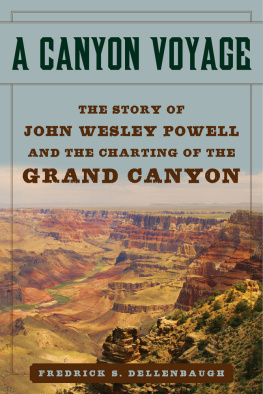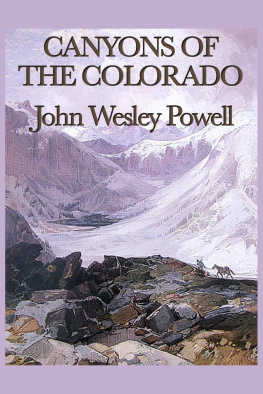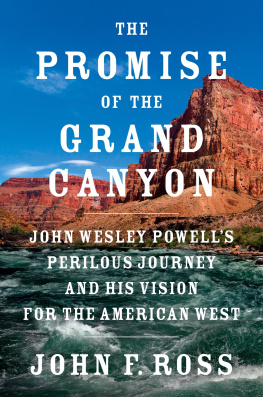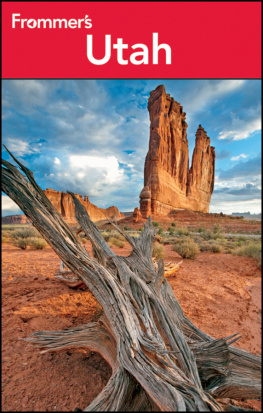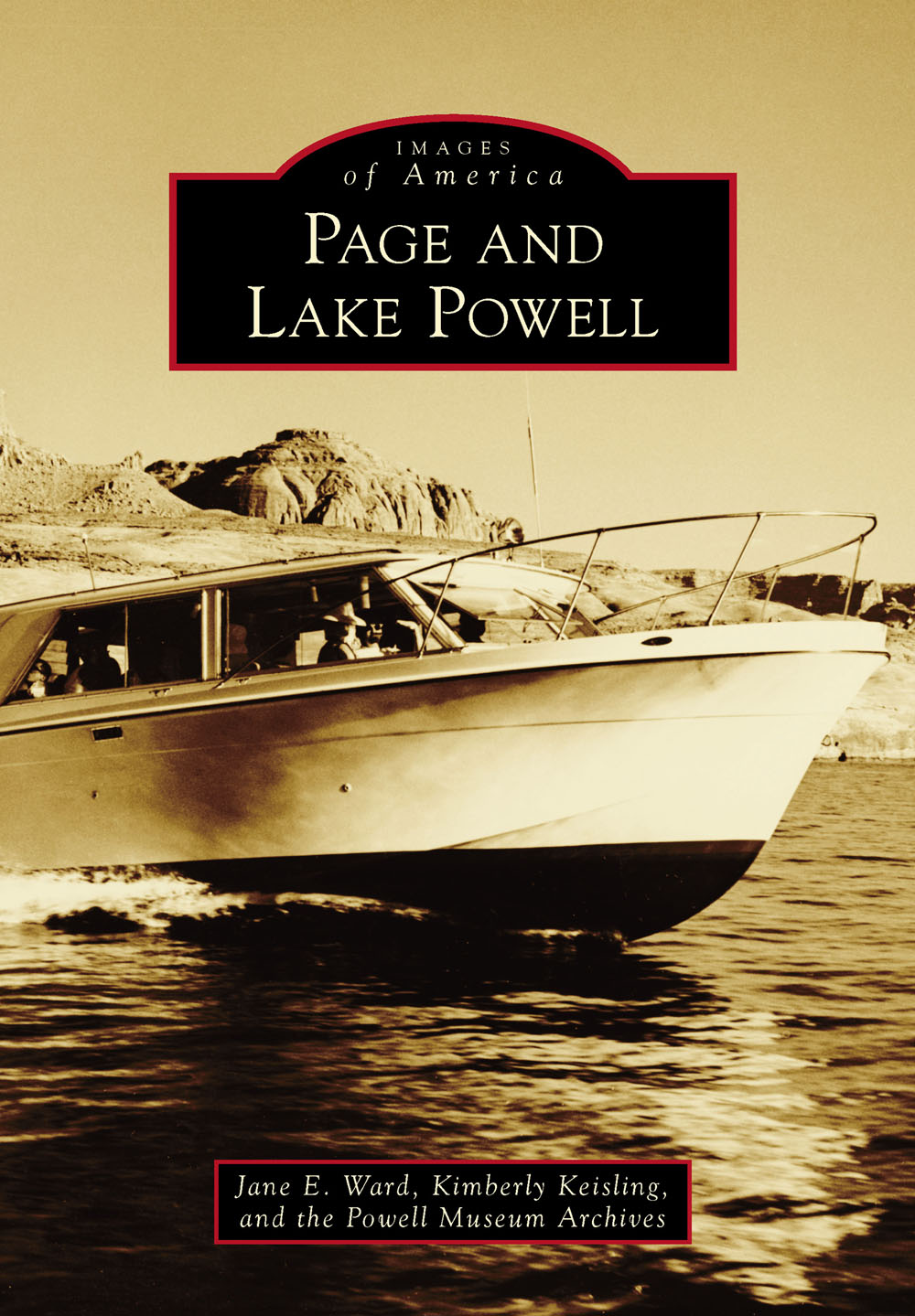
IMAGES
of America
PAGE AND
LAKE POWELL

Upon a sandy, windswept mesa, sheep foraged for sparse food while a lone, young Navajo man watched from a shaggy horse. Manson Mesa had fed the sheep of Manson Yazzies family for as long as one could remember, but that would soon end. A deal made in Washington, DChalf a world awayhad traded away the mesa so that workers on the nearby Glen Canyon Dam project would have a place to live. Paul Jones, chairman of the Navajo Tribal Council, offered Yazzies mesa in exchange for ancestral land on McCracken Mesa in Utah, which the tribe had wanted for a long time. Trade of this small tract of land (24.3 square miles) would forever change the entire landscape of the Navajo Reservation, as well as Northern Arizona and the West. Photographed on the rim of Glen Canyon on November 3, 1962, Merritt-Chapman & Scott Corporation high-scaler George Charlie is wearing traditional attire for a role in a US Bureau of Reclamation movie. (Photograph by A.E. Turner, US Bureau of Reclamation; courtesy of the Powell Museum Archives.)
ON THE COVER: The waters of Lake Powell began backing up behind Glen Canyon Dam in March 1963. It took almost 17 years for the lake to reach full capacity at 3,700 feet above sea level. Lake Powell has become the second largest man-made lake in the United States (behind Lake Mead). The reservoir was named for explorer John Wesley Powell and provides water storage, hydroelectric power, and a variety of recreational opportunities. The National Park Service manages Glen Canyon National Recreation Area, which encompasses Glen Canyon, Lake Powell, and extensive high-desert canyon lands in northern Arizona and southern Utah. (Photograph by the US Bureau of Reclamation; courtesy of the Howell R. Gnau Collection, Powell Museum Archives.)
IMAGES
of America
PAGE AND
LAKE POWELL
Jane E. Ward, Kimberly Keisling,
and the Powell Museum Archives

Copyright 2014 by Jane E. Ward, Kimberly Keisling, and the Powell Museum Archives
ISBN 978-1-4671-3158-2
Ebook ISBN 9781439645147
Published by Arcadia Publishing
Charleston, South Carolina
Library of Congress Control Number: 2013951306
For all general information, please contact Arcadia Publishing:
Telephone 843-853-2070
Fax 843-853-0044
E-mail
For customer service and orders:
Toll-Free 1-888-313-2665
Visit us on the Internet at www.arcadiapublishing.com
For Steven F. Ward, who dedicated his life to sharing his love for Page and Lake Powell.
CONTENTS
ACKNOWLEDGMENTS
The collection of photographs and history of the Page and Lake Powell area from early exploration through the 1980s would not be possible without the personal accounts of Page residents; documentation of people, places and events by forward-thinking individuals; and the dedicated staffs of local organizations working to preserve and keep the history of the area alive.
We would like to thank those involved in the Page Oral History Program overseen by the Powell Museum Archives, including the Page Public Library, Sara Beatty, Julia P. Betz, Karlyn Bunting, Linda Dieux, Richard Gilmore, Ada Hatch, Pam Jones, Stan Jones, Alley Keosheyan, Mary Melcher, Joan Nevills-Staveley, Bunny Nichols, Sharon Sichi, Cynthia Smith, Patricia Talbott, and Dorothy Warner. This invaluable historical resource includes more than 100 (and still growing) oral history interviews. Although each person remembers places and events slightly differently, the colorful stories and personal accounts bring life to the history of Page.
Most of the photographs included in the book were taken by the devoted staff of the US Bureau of Reclamation, including William A. Diamond, J.L. Digby, J.H. Enright, Fred S. Finch, H. Fink, Harry Gilleland, V. Jetley, Wilbur L. Rusho, A.E. Turner, and J.T. Vitaliano. A special thank you goes to the archival staffs of Glen Canyon National Recreation Area, the University of Utah Marriott Library, the Northern Arizona University Cline Library, and the Lake Powell Chronicle for providing access and permission to use important images from their collections.
We appreciate the support from individuals who donated collections, edited text, scanned images, combed the archives for important information, assisted in identifying photographs, and provided first-hand perspectives on the history of Page and Lake Powell, especially Julia P. Betz, Donna Bloxton-Petersen, Richard and Sharon Buck, Lillie Mae Gilleland, Brian Keisling, Mark Law, John Mayes, Dora Nelson, David and Debbie Sanderson, Cynthia Sequanna, Frank Talbott, Gay Ann Ward, Wanda Ward, Greg Woodard, and William Wright. We also extend a wholehearted thanks to the City of Page and all those who have worked tirelessly to make Page a wonderful place to live, work, and play.
INTRODUCTION
Prior to the early 1950s, what is now the city of Page, Arizona, was nothing more than a barren, sandy, desolate mesa in the isolated country of northern Arizona. Many people know the history of Page, including the construction of Glen Canyon Dam and Bridge, the filling of Lake Powell, and the transformation of the trailer town to the current, modern city it has become. As a well-known radio journalist frequently said, And now the rest of the story.
Part of Pages story includes frequent references to the town as the last real frontier in the Westindeed, the early residents were truly pioneers in their own right. Once the US government decided to build Glen Canyon Dam, engineers, surveyors, and construction workers descended by the thousands to an area basically known only to local Indian tribes. Located in one of the most remote locations in the United States, there were no amenities in the area: no gas stations, no stores, no running water, no houses, and very few roads. In this country of beautiful mesas, buttes, canyons, and plenty of red sand, this hardy band of workers set out to build one of the most demanding projects in the history of the US Bureau of Reclamation: Glen Canyon Dam.
During the early construction years of the late 1950s, housing in Page was limited to only small mobile homes. People arriving to work on the dam were mostly strangers to one another, yet friendships developed quickly. As a new family came to town, others arrived to help them unload and move in. A lack of things to do only contributed to the closeness among residents who relied on one another and their own creativity for fun and entertainment. Children, especially, forged friendships that still endure today.
Life in developing Page was not always easy, and more of the rest of the story would have to include the blowing sand, which could literally cover the floor of a home. Scoop shovels rather than brooms were often used to clean houses following one of the frequent sand storms. Another unforgettable experience was crossing Glen Canyon on a swinging bridge with the Colorado River hundreds of feet down and the bridge swaying in the wind. The experience was not for the faint of heart, but early on it was the only way to get from one side of the canyon to the other.
Living in the isolation of Page only contributed to the growing spirit of helping others and volunteering for work that needed to be done in the developing town: building churches, a nine-hole golf course, a swimming pool, homes, parks, and playgrounds. Everyone pitched in, and helping others soon became a way of community life.
Next page


